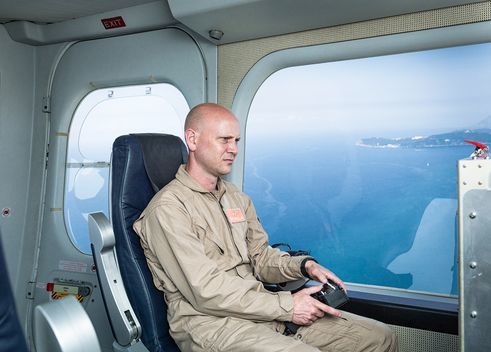Networks and data flows are increasingly objects of surveillance and control. Three exhibitions in Munich and Berlin show how photo artists in Germany are approaching the theme of surveillance.
Berlin is probably the only city in the world with not just one, but two whole museums dedicated to the theme of surveillance and espionage. The Spy Museum Berlin, which seeks to make accessible to tourists with lavish multi-media installations the ways in which Germans and Allied forces spied on each other during the Cold War, is located on Leipziger Platz. It also deals with the ways German governments investigated their own people – under the National Socialists and the GDR. And in the Normannenstraße in Lichtenberg one can visit the StaSi headquarters, which permits a unique internal perspective on this covert agency.
The continuity of surveillance in various periods of German history is also the reason why in Germany to this day such great importance is attached to protection of the private sphere, and why the NSA revelations of whistleblower Edward Snowden were received with especial outrage. A series of cultural institutions has also taken up this theme. Following the exhibition Global Control and Censorship at the Centre for Art and Media/ Zentrum für Kunst und Medientechnologie in Karlsruhe (2016), in 2017 exhibitions can be seen at the Berlin Museum of Photography/Berliner Museum für Fotografie and at the Munich City Museum/ Münchner Stadtmuseum. They show how artists are responding to the fact that the world seems to be focused on transforming itself into an immense digital panopticon, and reporting on both the allure and the danger of digital self-surveillance through the use of the internet, smart-phones and social media.
The exhibition Watching You, Watching Me in the Museum für Fotografie, organised by George Soros’ Open Society Institute and previously to be seen in New York and Budapest, concentrates on assembling works that deal with pictorial material found in archives or the internet. Almost at the same time, the Munich City Museum shows the exhibition No secrets! – Images of surveillance. Works of contemporary artists on different – also historical – topics of surveillance can be seen there.
-
 © Edu Bayer
© Edu Bayer
Edu Bayer, Libya‘s internet surveillance center, Tripoli, Libya, August 30, 2011 | From the series Qaddafi Intelligence Room,
-
 courtesy Simon Menner/BStU
courtesy Simon Menner/BStU
Simon Menner, Untitled, 2013 | Stasi agent during a seminar on disguises
-
 © Andrew Hammerand
© Andrew Hammerand
Andrew Hammerand, Detail from The New Town, 2013 | Installation comprised of 21 color photographs
-
 Courtesy Paolo Cirio
Courtesy Paolo Cirio
Paolo Cirio, Street Ghosts | installed at 9 Adalbertstraße, Berlin, Germany
-
 © Mishka Henner
© Mishka Henner
Mishka Henner, Nato Storage Annex, Coevorden, Drenthe, 2011 | From the series Dutch Landscapes
-
 © Florian Freier
© Florian Freier
Florian Freier, Cached Landscapes II Egelsbach Transmitter Facility, 2015
-
 © Max Eicke
© Max Eicke
Max Eicke, USAG Wiesbaden Military Training Area Mainz, 2015
-
 © Jens Klein
© Jens Klein
Jens Klein | Aus der Serie: Briefkasten | Fotos aus Personenakten der Stasi-Unterlagenbehörde, 2012
German artist Simon Menner, who hung up on the walls completely un-retouched photos from the archive of the Ministry of State Security of the GDR, addresses the German tradition of surveillance. The fact that one can work so utterly unhindered with the relics of a clandestine service is surely also a further German singularity: after the downfall of the GDR, the StaSi’s operations were laid open to the public and reviewed by the StaSi Records Agency, an office set up specially for this purpose.
The West German Federal Intelligence Service (Bundesnachrichtendienst /BND), which exists to this day, is considerably less accommodating where insights into its internal doings are concerned. The BND hardly ever grants peeks behind its curtains. Only the planned move of BND headquarters from Pullach in Bavaria to Germany’s capital of Berlin enabled photographer Alessandra Schellnegger to explore the already largely empty offices with her camera in 2013. Her photos can also be seen in a solo exhibition entitled
Insights. Behind the walls of the BND in Pullach at the Munich City Museum and allow a first and at the same time last look behind the four-kilometre long wall behind which German spies went about their work.
-
 Photo and © Alessandra Schellnegger
Photo and © Alessandra Schellnegger
Gateway, from the series "Insights. Behind the Walls of the BND in Pullach“, 2013
-
 Photo and © Alessandra Schellnegger
Photo and © Alessandra Schellnegger
Shooting range, from the series: "Insights. Behind the walls of the BND in Pullach ", 2013
-
 Photo and © Alessandra Schellnegger
Photo and © Alessandra Schellnegger
Barracks, from the series: "Insights. Behind the walls of the BND in Pullach ", 2013
